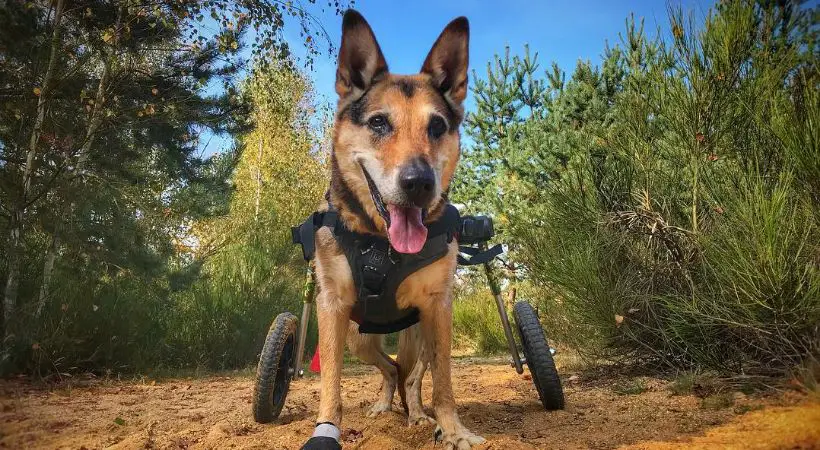Canine Degenerative Myelopathy When to Euthanize?
If you own a dog, you can attest that having a severely ill dog can be harrowing. Dogs suffer from various ailments. Some are simple, while others are complex. One of the complex conditions dogs can suffer from is degenerative myelopathy. When a dog gets diagnosed with degenerative myelopathy, it might need to be euthanized in 6 months.
Deciding to euthanize a dog with degenerative myelopathy can be very difficult. You will need to talk with a vet and be sure it is just the right thing to do before going ahead.
Contained in this article are tips to help you know the right time to euthanize a dog with degenerative myelopathy.
When is the Right Time to Euthanize a Dog with Degenerative Myelopathy?
It is best to euthanize a dog with degenerative myelopathy between six months to three years after it has been diagnosed in lots of cases. It is not in your place to make this decision. Your vet will examine your dog and tell you how this illness can impact the quality of its life. It is also in your vet’s place to tell you it is time to euthanize your dog.
What is Degenerative Myelopathy?
Before going ahead to consider euthanizing a dog with degenerative myelopathy, you should know what the disease is about. When you understand the disease and its effect, you will have an idea of the right time to euthanize your dog when it gets affected by this disease.
Degenerative myelopathy in dogs is when the white matter in a dog’s spinal cord gets degraded. This happens gradually, and it involves the nerves in the spinal cord losing the ability to relate with impulses.
This degradation of the dog’s spinal cord’s white matter begins in the middle of the dog’s back. It then moves to the bottom and the top. It gradually results in your dog being paralyzed in its hind leg.
This disease has a gradual progression. You, therefore, might not see it coming or notice it taking place until your dog is fully affected.
Although this disease takes time to become severe, it always leads to death. The only slightly good thing about this condition it does not cause pain to lots of dogs.
What are the Symptoms of Degenerative Myelopathy?
Canine degenerative myelopathy has various symptoms. These symptoms are dependent on what stage of the sickness a dog is on. This disease has three different stages. They are the early stage, the intermediate stage, and the late stage. When you take your dog to a vet for diagnosis, it is in your vet’s place to tell you what exact stage of this condition your dog is in.
When your dog begins approaching the intermediate and late stage, you might have to start considering the alternative of putting-down your dig. This is because your dog’s quality of life will reduce very rapidly.
The symptoms of the early stage are;
- Stumbling about
- Muscle loss in the back legs
- Pulling of the back feet, which leads to the wearing down of the toenails.
- Your dog’s paws’ inner digits begin to wear out.
- Back leg tremors
- Your dog begins to scrape its nails on the ground occasionally.
- It feels weak in its hind leg. This leads to difficulty when climbing stairs and going for a walk.
- The toes start knuckling.
- It becomes difficult for the hind legs to be coordinated.
- Difficulty in standing.
Symptoms of the Intermediate Stage are;
- Walking on its paw instead of through pads
- Tail hanging limp
- The dog becomes unable to feel where its paws are being placed. This lands on the crossing of the hind legs
- Bad balance
- Walking without aid becomes difficult.
- Atrophy of the muscles
- Loss of muscle mass in its back. Also, there is a sagging appearance in its backend.
- Your dog might struggle to rise.
- Struggling to urinate and pass feces.
Late Stage
- Loss of balance and coordination. Due to this, your dog will need support while walking, squatting, and standing. It will also be impossible for your dog to get up without any help. If euthanization is not done, it will be impossible for the dog to help itself.
- Organ failure and respiratory challenges take place at this stage.
- The hind leg gets paralyzed.
- Your dog exhibits uncontrolled and jerky movements.
- Weakness in the legs and shoulders.
What Causes Degenerative Myelopathy?
At the moment, the whole reason for this condition is yet to be discovered. Nonetheless, there are a couple of factors that could increase your dog’s chances of being affected by this condition. Popular among these factors are genetics, breed, and age.
Genetics: According to research, one of the significant factors that play a role in developing degenerative myelopathy in your dog is genetics. This makes it essential to ask a shelter or breeder selling a dog to you if your dog’s parents have had this condition or any other medical condition that is related to this. Your dog will most likely suffer from this condition if one or both of its parents already suffered from it.
The SOD1 mutation causes degenerative myelopathy. The presence of this gene in any of your dog’s parents means your dog is a carrier. If your dog’s parents possess this mutation, then your dog is at risk of being affected by this condition.
Are you unsure of what your dog’s heritage is? If yes, to be sure and on the safe side, you will need to visit a vet and put your dig through a genetic test.
With this genetic test, you can find out if your dog has this genetic mutation or not. While it is essential to know if your dog has this genetic mutation or not, the presence of this genetic mutation does not guarantee your dog developing this condition later in its life.
Breed: Originally, most people thought only German Shepherds were affected by degenerative myelopathy. Due to this, the condition was called ‘German Shepherd Disease.’ However, based on recent studies, there are many dog breeds that can suffer from degenerative myelopathy. Therefore, you will need to know the dog breeds that this condition can affect if you want to avoid it.
Although certain dog breeds are more likely to get affected with degenerative myelopathy, many dog breeds are affected by this condition even in a minimal way. Some of these dog breeds are Shetland Sheepdog, Pug, Poodle, Golden Retriever, German Shepherd, Corgi, Burmese Mountain Dog, and American Eskimo Dog.
Age: This health condition is popular in senior dogs. Most dogs affected by it are usually between the ages of 8 and 9 when the diagnosis is made. Dogs in this age range suffer from arthritis and other age-related diseases. This explains why it might be challenging to notice the symptoms of this condition in your dog initially. Nonetheless, since this condition is a common one in aging dogs, you should see your vet immediately once you notice any symptom that could be attributed to it.
How Long Can a Dog Exist with Degenerative Myelopathy?
At this point, you know about some of the causes of degenerative myelopathy and the dog breeds that it can affect. Therefore, you will need to know how long your dog can live after being diagnosed with this condition. Many dogs will only live six months to three years after they are diagnosed with degenerative myelopathy. Although dogs with this condition are expected to live for a certain period, you can prolong your dog’s life by giving it the right form of treatment. Nonetheless, as soon as it cannot move anymore, euthanization will be the next step.
Is Degenerative Myelopathy a Painful Condition?
Although degenerative myelopathy seems like a painful condition, in lots of cases, it is not painful. When dogs are in the early stages of this condition, they can still exercise. This is regardless of the disabilities they are dealing with at the time.
How do you Know the Right Time to Euthanize your Dog?
There are certain vital factors you should consider before euthanizing a dog with this health condition.
This disease is in various stages, and the symptoms become more severe as the stages progress.
Your vet will have to examine your dog and tell you when it is right to euthanize your dog. It, however, is up to you to finally decide to euthanize your dog. This is because you know your dog better than any other person. Since you spend the most time with your dog, you can tell if it is conformable.
It would help if you considered how your dog’s days go and how weak its muscles are before deciding to euthanize it or let it hang on a little.
While lots of people are tempted to keep their dogs for long, lots of people end up regretting this action. At the initial stages of this condition, it might not seem so severe. Nonetheless, the later stages are terrible and will make you wish you euthanized your dog much earlier.





